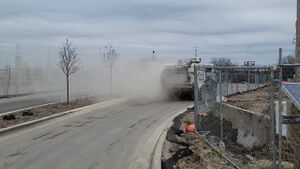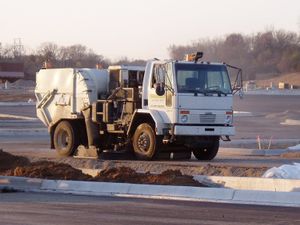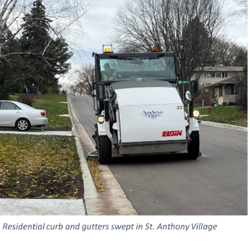
Sediment control practices - Pavement sweeping
|
Pavement sweeping is the use of street sweepers (mechanical broom and vacuum sweepers) as a best management practice (bmp) for sediment control on construction sites. The practice is used to remove tracked sediment from the construction site onto the paved road surface. This bmp is also necessary to properly clean paved surfaces in preparation for final paving.
Pavement sweeping should be used to supplement vehicle tracking bmps at a construction site.
Contents
Purpose and function
Vehicles leaving construction sites can track sediment onto adjoining roadways, which contributes to sediment pollution in waterways. The purpose of pavement sweeping (and vacuuming) is to prevent tracked sediment from entering storm drains or surface waters. Pavement sweeping removes sediment, trash and associated pollutants (such as nutrients) from roadways in or near construction sites. Using sweepers on paved surfaces also limits airborne dust by preventing dust buildup. Combining the use of a mechanical broom sweeper followed by vacuum sweeping will give the best results for limiting dust build up. Pavement sweeping is an important and often necessary bmp at construction sites, resulting in improved aesthetics and safety of roadways; dust control; and decreased accumulation of sediments, trash, and pollutants in storm drains and surface waters.
Applicability
Pavement sweeping is used anywhere in or near construction sites where vehicles may track sediment from the project site onto paved roadways, typically at jobsite exits. Sweeping and vacuuming are also used during preparation of paved surfaces for final paving. Sweeping and vacuuming effectiveness will be reduced when soil is wet, muddy or caked onto the paved surface (caked soil will need to be scraped loose).
Site applicability
Pavement sweeping is necessary during the construction period for all sites with vehicles passing through disturbed areas prior to entering public roadways or other offsite areas.
Permit applicability
MPCA issues coverage to construction site owners and their operators under the Construction Stormwater (CSW) General Permit to prevent stormwater pollution during and after construction, and to protect Minnesota's water resources. Minnesota's 2018 CSW General Permit states that the permit owner must develop a Stormwater Pollution Prevention Plan (SWPPP). The SWPPP must include the location and type of all temporary and permanent erosion prevention and sediment control bmps along with procedures used to establish additional temporary bmps as necessary for the site conditions during construction. Permittees must establish sediment control bmps on all downgradient perimeters of the site and downgradient areas of the site that drain to any surface water, including curb and gutter systems. Section 9.12 of the CSW permit specifically states that permittees must use street sweeping if vehicle tracking bmps are not adequate to prevent sediment tracking onto the street.
Section 11.6 of the CSW permit states that permittees must inspect construction site vehicle exit locations, streets and curb and gutter systems within and adjacent to the project for sedimentation from erosion or tracked sediment from vehicles. Permittees must remove sediment from all paved surfaces within one (1) calendar day of discovery or, if applicable, within a shorter time to avoid a safety hazard to users of public streets.
Additionally, OSHA’s Safety and Health Regulations for Construction regarding respirable crystalline silica states that the employer shall not allow dry sweeping or dry brushing where such activity could contribute to employee exposure to respirable crystalline silica unless wet sweeping, HEPA-filtered vacuuming or other methods that minimize the likelihood of exposure are not feasible. See 1926.1153(f)(1).
Effectiveness
Pavement sweeping is an effective way to reduce sediment concentrations in stormwater runoff. Effectiveness is generally defined as the efficiency of the sweeper, which varies depending on location, sweeping frequency, type of sweeper used, characteristics of the impervious surface (e.g., roughness, grade), operation factors (e.g., speed) and maintenance. Improperly or poorly maintained sweepers will be ineffective, costly and can exacerbate site conditions by increasing airborne dust. Vacuum and regenerative air sweepers are typically more effective than mechanical broom sweepers at removing fine particulates; however, mechanical broom sweepers may be more effective at removing coarse sediment and large debris. Recent studies also show that the efficiency of newer mechanical broom sweepers may be increasing (Hixin and Dymond 2019). The best option for construction sites is to use a mechanical broom sweeper followed by a vacuum sweeper. Pavement sweeping is most effective at construction sites when sweeping is conducted at the end of each work day, during dry conditions and when material loads have not been allowed to be caked on to pavement surfaces prior to sweeping. Frequency of street sweeping at construction sites will vary and may need to be increased based on site conditions, volume of construction traffic and inspections.
Sweeper efficiency is typically represented as the portion of sediment removed by the sweeper. The overall efficiency can range from low (5%) to high (>90%) depending on the sweeper type and other factors. Sediment removal efficiencies for mechanical broom sweepers range from 5 – 57%, while regenerative air efficiencies range from 25 – 90% and vacuum sweeper efficiencies range from 30 – 92%. However, these efficiencies can only be met when sweeping equipment is properly maintained and operating at optimal factory adjustments. Mechanical broom sweepers must have properly functioning brooms, conveyors, shields and on-board water dust suppression systems. Likewise, regenerative air and vacuum sweepers must have properly functioning rubber seals, shields, flaps, filters and/or water dust suppression systems or they will not perform efficiently and will even increase and significantly contribute to airborne dust contamination.
Weston (2010) evaluated the changes in stormwater runoff water quality as a result of sweeping and found that mean TSS reductions ranged from 74% to 85% in runoff samples collected directly from street gutters on swept streets compared to unswept streets.
Planning considerations
When planning for pavement sweeping at a construction site consider the following:
- Use one of three or a combination of sweeper options: mechanical broom sweeper, dry vacuum sweeper, or regenerative air sweeper (see Implementation section for more details). The preferred option is mechanical broom followed by a vacuum sweeper.
- Multiple or tandem sweeping operations can be more efficient reducing time and costs on larger construction sites.
- Pavement sweeping effectiveness will be reduced when sediment is saturated or when soil is caked on the asphalt. Caked soil will need to be scraped loose. Washing is not an alternative to sweeping and vacuuming because of the risk of pollutant transport.
- Use sweeping with water dust suppression methods when possible. If water must be used to pretreat or flush pavement, allow sediment to settle out of any runoff, collect sediments and protect storm drain inlets. If water is used, the quantity of water should be carefully managed to prevent excess water that can cause erosion or runoff (especially when storm drains are present).
- Use in conjunction with vehicle tracking BMPs such as tire wash facilities and rock pads at the construction entrance/exit.
- Pavement sweeping works best when it is one of several BMPs making up a stormwater management plan including structural BMPs such as perimeter controls, storm drain inlet protection, and sediment traps and basins. See: Sediment control practices - Minnesota Stormwater Manual
- Plan for proper disposal of sweeper waste at an approved dumpsite or consider incorporating sediment back into the project site if it is free of trash and debris.
Implementation recommendations
Use one of three sweeper types or a combination of the following sweeper options when pavement sweeping is required. Note that the preferred option is mechanical broom followed by a vacuum sweeper.
- Mechanical sweeper
- Vacuum-assisted, dry, waterless, sweeper
- Regenerative-air sweeper
The mechanical broom sweepers are used to pick up large-grained sediment particles and remove packed-down soil on a construction site. Mechanical sweepers are more effective on uneven road surfaces and where obstacles such as exposed manholes and gate valves are present. Mechanical broom sweepers are also more effective and safer along exposed curb edges that are present before final pavement or wear course has been installed. Mechanical sweepers tend to create more dust that air sweepers, which can increase atmospheric emissions as well as the amount of fine sediment that travels to surface waters. In locations where soil is not packed down, road surfaces are level and the majority of large-grained sediment has already been removed, an air sweeper may be used. Regenerative air and vacuum sweepers are more efficient than mechanical sweepers with respect to fine-grained sediment. Therefore, the use of a mechanical broom sweeper followed by a vacuum-assisted sweeper is the preferred option and will provide the best results. Regenerative air sweepers should only be used on a construction sites to finish-sweep or to periodically reduce fine sediment during heavy hauling operations. Poorly or improperly maintained sweepers will create more dust, this will increase atmospheric emissions as well as the amount of fine sediment that travels to surface waters.
Specific implementation recommendations include:
- Limit the number of points where vehicles can leave the project site to allow sweeping and vacuuming efforts to be focused.
- Inspect potential sediment tracking locations daily, including all job site exits, new and existing roadways, construction parking, curbs, gutters, and any other onsite paved areas.
- Street sweeping or vacuuming should be conducted when there is noticeable sediment accumulation on roadways adjacent to the construction site.
- Use sweeping on paved areas where dust and fine materials accumulate as a result of truck traffic, pavement-structure construction activities, and deposition from adjacent disturbed areas. Any visible onsite and offsite sediment tracking should be swept or vacuumed. At a minimum, sweep daily in heavily trafficked areas. Increase frequency if needed to maintain cleanliness.
- If sweeping causes excessive dust, pretreat area with water. Do not over saturate. Allow it to dry to a moist consistency before sweeping. If water is used, the quantity of water should be carefully managed to prevent excess water that can cause erosion or runoff (especially when storm drains are present).
- Do not use kick brooms, flick brooms or sweeper attachments. These tend to spread the dirt rather than remove it.
- If tracked sediment is overly saturated or caked on the paved surface it will need to be scraped loose and collected prior to sweeping or vacuuming.
- Skid steer style bucket brooms can be used in small corners and difficult to reach areas. They should never be used in-place of a larger and safer full-size sweepers. Water should always be used to suppress fugitive dust when running this equipment.
- Never wash accumulated sediment on roadways into storm drains.
- Dispose of the collected sediment, debris, and trash properly. If the removed sediment swept or vacuumed up is not mixed with debris or trash, consider incorporating it back into the project. See: Disposal options for street sweeping materials - Minnesota Stormwater Manual
- It is recommended that the operators keep street sweeping activity records including sweeping times, locations, and the quantity of material collected if appropriate.
Inspection and maintenance
- After implementing pavement sweeping and/or vacuuming, inspect any potential sediment tracking locations on a daily basis and sweep tracked sediment as needed to reduce sediment accumulation on roads. Sediment tracking locations to inspect include any construction site exit points, paved roads around the perimeter of the construction site and on-site paved roads. Street sweeping may be needed more frequently than daily, based on site conditions, traffic levels and inspection results.
- Following street sweeping, inspect, restore and clean out inlet protection BMPs that may have been impacted during street sweeping.
- Inspect and sweep paved areas for sediment prior to forecast rain.
- Inspect areas to be swept for materials that may be hazardous prior to beginning sweeping operations. Be careful not to sweep up any unknown substance or any object that may be potentially hazardous.
- Adjust sweeper brooms, conveyors, rubber seals, shields and flaps frequently to maintain proper contact with the ground and maximize the efficiency of sweeping operations. If the sweeper is not picking up sediment or is generating large amounts of dust, immediately cease sweeping operations until the sweeper is inspected, repaired and adjusted for proper operation.
Cost
The cost of pavement sweeping as a BMP on construction sites varies depending on several factors such as the type of sweeper being used, the size of area to be swept, the amount of sediment collected, and cleaning frequency. Pavement sweeping is typically considered to have a low to moderate cost-effectiveness compared to other BMPs at a cost of approximately $3 – $5 per pound of sediment removed (Hunt 2017).
The University of Florida conducted a study of 14 MS4s (Municipal Separate Storm Sewer Systems) in Florida and found that street sweeping is the most cost-effective BMP for stormwater pollution compared to structural BMPs with the lowest cost per pound for removal of total phosphorus (TP), total nitrogen (TN) and particulate matter (PM). The pavement sweeping costs used to determine the total costs for pavement sweeping in the study were based on street sweeping by subcontractors at $30.14 per curb mile (2011 dollars). The subcontractor cost was utilized so sweeper purchase and maintenance costs were not taken into account. The costs did not include solid waste landfill disposal (see Disposal options for street sweeping materials – Minnesota Stormwater Manual for a range of disposal costs).
Mechanical broom sweepers are typically the least expensive type of sweeper and are best used for picking up large-grained sediment particles. Regenerative air and vacuum sweepers are typically more expensive that mechanical broom sweepers but are more efficient at picking up fine-grained sediment.
Some rental rates from California (for years 2007 and 2009) have been reported as $58/hour (3 yd3 hopper) to $88/hour (9 yd3 hopper), plus operator costs. Other rental rates for southern California are reported as between $100-$150 an hour.
Reference materials
Except where more stringent requirements are present, pavement sweeping shall comply with Minnesota’s NPDES/Construction Stormwater Permit.
The following is a list of additional resources that are not specific to Minnesota:
- Amato, F., X. Querol, C. Johansson, C. Nagl, and A. Alastuey. 2010. A review on the effectiveness of street sweeping, washing and dust suppressants as urban PM control methods. Science of the Total Environment. 408(2010):3070–3084.
- Berretta, C., S. Raje and J. J. Sansalone. 2011. Quantifying Nutrient Loads Associated with Urban Particulate Matter (PM), and Biogenic/Litter Recovery through Current MS4 Source Control and Maintenance Practices. Gainesville, FL.
- California Stormwater BMP Handbook - Construction (CASQA 2009)
- Caltrans Construction Site Best Management Practices (BMP) Manual. 2017.
- City of Seattle Stormwater Manual Volume 2 - Construction Stormwater Control 2021.
- Construction Stormwater Field Guide - American Association of State Highway and Transportation Officials Construction Stormwater Field Guide - American Association of State Highway and Transportation Officials (Center for Environmental Excellence 2016)
- CWP (Center for watershed Protection). 2016. Cost-Effectiveness Study of Urban Stormwater BMPs in the James River Basin. Ellicott City, MD.
- Hixon, L.F. and R. L. Dymond. 2019. Characterization of Street Sweeping Material for Addressing Total Maximum Daily Waste Load Allocations. Journal of Sustainable Water in the Built Environment. 5(3): 04019003.
- Kidwell-Ross, R. 2007. Construction Sweeping: Safely and Efficiently. Better Roads.
- Mile High Flood District Urban Storm Drainage Criteria Manual Volume 3. 2010.
- Montana Department of Transportation Erosion and Sediment Control Best Management Practices Manual. 2016.
- MPCA - Recommended street sweeping practices for water quality purposes. Minnesota Stormwater Manual
- Rhode Island Soil Erosion and Sediment Control Handbook. 2016.
- Schueler, T., E. Giese, J. Hanson and D. Wood. 2016. Recommendations of the Expert Panel to Define Removal rates for Street and Storm Drain Cleaning Practices. Ellicott City, MD.
- University of California Santa Barbara Construction Stormwater Best Management Practices. 2009.
- University of Florida. 2019. Municipal Separate Storm Sewer System (MS4) Practices Assessment Phase III - Reclaimed Water Areas. Gainesville, FL.
- USEPA (United States Environmental Protection Agency). 2021. Stormwater Best Management Practice, Parking Lot and Street Sweeping. EPA-832-F-21-030J. Washington, DC.
- Weston (Weston Solutions, Inc.). 2010. City of San Diego Targeted Aggressive Street Sweeping Pilot Study Effectiveness Assessment. Carlsbad, CA.
- Yolo County Improvement Standards Section 11 Stormwater Quality, Erosion and Sediment Control. 2006.
This page was last edited on 22 March 2023, at 14:03.




